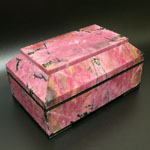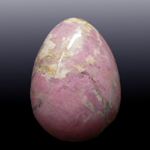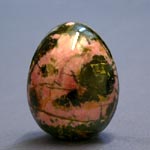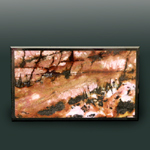Stone, minerals and semiprecious of the world stone
Amphiboles (silicates): Rhodonite -->rus
 Diagnostic cart.
Diagnostic cart.
On a photo. Tablitchatye crystals of rhodonite from New Jersey (USA).
Ca Mn4 Si5O15
Crystal structure triclinic
Hardness on the Mohs scale 5,5-6,5
Specific unit weight mass 3,4-3,73
Cleavage perfect absolute
Fracture, break wrong
Colors pink, rose, brown
Colors in powder triturate white
Glance (glitter, glare) glassy

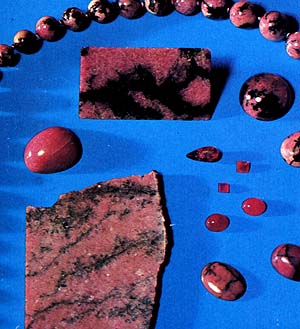 Got the name, as well as rhodochrosite, in color. Black dendrites, formative the picture of stone, is composed the oxides of manganese. Differences with a strong brownish or yellow tint are named fowlerite.
Got the name, as well as rhodochrosite, in color. Black dendrites, formative the picture of stone, is composed the oxides of manganese. Differences with a strong brownish or yellow tint are named fowlerite.
Crystals of this mineral usually plate tablet lamellar with chamfered tops, and also scaly or almost lamellar tabular. Cleavage perfect absolute. More frequent rhodonite is presented as the masses of grainy or dense addition. Colouring is rose, enough intensive, often hazel from superficial changes or with the black spots of oxides of manganese, for example, of pyrolusite.
Rhodonite is transparent, brilliance of glassy, on the surfaces of cleavage of mother-of-pear nacreous. Hardness on the Mohs scale moderate, mineral heavy, easily divided on cleavage almost at right angles. A rose-tinted, pinkish, whitish pink, brownish translucent mineral consisting of manganese silicate in triclinic crystalline form with calcium, iron, or magnesium sometimes replacing the manganese. It occurs in metamorphic rocks, esp in New Jersey and Russia, and is used as an ornamental stone, glaze, and pigment. Formula: MnSiO3, from German Rhodonit, from Greek rhodon rose + -ITE.
Chemical composition (chemistry, compound). Freoxide (MnO) 30-46%, protoxide of iron (FeO) 2-12%, kemidol (CaO) 4-6,5%, silex (SiO2) 45-48%. Form of crystalline excretions. Crystals usually are badly formed, more frequent mineral is presented dense downlow or short-grained the masses. Class of symmetry. Pinacoidal - 1. Cleavage. not fully perfect absolute to on (110), (110). Aggregates. Dense, downlow.
Diagnostic indication.
Not added the action of acids, melt fuse enough easily, giving vitreous glassy mass of red or brown color. Nazvnie mineral got from a greek word "Rhodes" is a rose or rose-coloured, pink. The large percent of manganese which gives this mineral an original color is included in chemical composition of rhodonite. In oxidizing flame a manganese oxidizes and mineral russets, blacken. A behavior is in acids. Slowly dissolves in muriatic acid.
Origin provenance genesis.
Rhodonite be found in an association with other minerals in the different deposits of manganese. More frequent than all it appears at metamorphism of manganese, manganous of carbonate rocks with the admixture of silica.
Deposit minefield mine field occurrence subsoil.
Among numerous locations, supplying or supplying with the excellent copies of rhodonite, will mark Longban and Paysberg in Sweden, Franklin-fernes (the state is New Jersey) and Byutt (the state is Montana) in the USA; Broken-khill in Australia. The best standards of jeweller quality act from Tanzania and Canada. In the middle of XIX century this beautiful stone was widely used in the Russian rock-cutting art. Deposits are developed on Ural, and also in Sweden (Vermland), Australia (transparent variety), USA (Vancouver), Canada, India, on Madagascar, in Mexico and Republic of South Africa.
Use is on jeweller business.
Rhodonite is used on jeweller business with cutting in cabochon or sphere. Out of him also entail make for a necklace, bangles, statuettes and other arts and crafts. Used as decorative carpentry and jeweller stone - for making of beads, cabochon and articles of rock-cutting art, sometimes - for the decoration of interior. Entangling is possible with a rhodochrosite and thulite.
